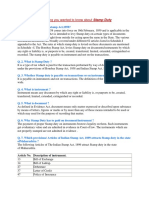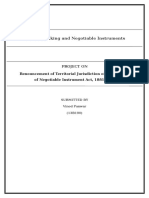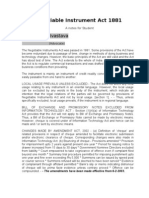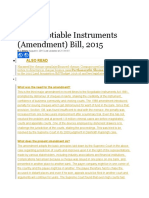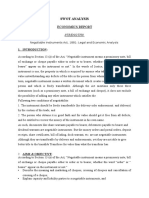0 ratings0% found this document useful (0 votes)
5 viewsStamp Act
Stamp Act
Uploaded by
shubhankar mishraCopyright:
© All Rights Reserved
Available Formats
Download as DOCX, PDF, TXT or read online from Scribd
Stamp Act
Stamp Act
Uploaded by
shubhankar mishra0 ratings0% found this document useful (0 votes)
5 views4 pagesCopyright
© © All Rights Reserved
Available Formats
DOCX, PDF, TXT or read online from Scribd
Share this document
Did you find this document useful?
Is this content inappropriate?
Copyright:
© All Rights Reserved
Available Formats
Download as DOCX, PDF, TXT or read online from Scribd
Download as docx, pdf, or txt
0 ratings0% found this document useful (0 votes)
5 views4 pagesStamp Act
Stamp Act
Uploaded by
shubhankar mishraCopyright:
© All Rights Reserved
Available Formats
Download as DOCX, PDF, TXT or read online from Scribd
Download as docx, pdf, or txt
You are on page 1of 4
OVERVIEW OF STAMP ACT
Indian Stamp Act was amended in 1899 by the British
Government with the sole purpose of acting as a revenue-
generating mechanism for the Government.
imposes liability to pay stamp duty on certain and specific
documents.
Stamp Duty
Basically, stamp duty is a tax which is paid on the exchange of
documents or execution of instruments.
There are basically two kinds of stamp duty and they are:
1. Impressed stamp - An impressed stamp is produced by the
process of engraving or embossing. The labels in impressed
stamps are affixed and these impressions are done by franking
machines in the bank.
2. Adhesive stamp - Adhesive stamps are those stamps which
can be stuck to a document using any form of adhesive. There
are two types of adhesive stamps and they are:
a. Postal stamps- Postal stamps have their limited application.
Postal stamps are used for post office related transactions.
b. Non-postal stamps- non-postal stamps have wider
application compared to postal stamps. Non-postal stamps are
revenue stamp, court fee stamp, insurance policy stamp etc.
There are certain very important terms that are related to The
Indian Stamp Act, 1899.
Conveyance- Section 2 (10) of the Act defines the term
conveyance.
Duly Stamped- Section 2 (11) defines this term.
Instrument- Section 2(14) defines the term instrument.
Valuation of Instrument for levy of stamp duty
As we already know that Instruments are chargeable with duty
but then it raises another question and that is how is the
valuation of instruments is done, the answer to that question is
from Section 20 to Section 27 excluding Section 22 of The
Indian Stamp Act.
Section 20 of the Act states that where an instrument is
chargeable in respect of money in any currency other than that
of India then, in that case, the duty shall be calculated on Indian
currency and the exchange rate shall be applicable on the date
of the instrument.
Section 21 provides that where an instrument is chargeable
with ad valorem duty in respect of stock, securities then, in that
case, the value of the day is calculated by the average price of
the stock or security in the day of the instrument.
Section 23 deals with interest, it states that where interest is
payable by the terms of an instrument in such a case the value
of the duty shall not exceed the charge by which it would have
been initially chargeable.
Section 24 states that duty is also payable on the amount of
debt when a property is transferred wholly or partially.
Section 25 talks about the computation of duty in the case of
annuity
Section 26 states that where the instrument is chargeable with
ad valorem duty but the value of the subject matter cannot be
ascertained at the date of its execution, then, in that case, the
executants can value the instrument as they please. However,
they cannot recover under such a document any amount which
is more than the amount of stamp duty that has been paid.
Section 27 sets that parties of an instrument are bound to set
forth all the facts and circumstances affecting the chargeability
of an instrument.
By whom stamp duty is payable
Section 29 of the Indian Stamp Act provides for the person who
is liable to pay the stamp duty.
1. Administration bond agreement, pawn agreement, pledge
agreement, bills of exchange, bonds- In such instruments the
person who is drawing, making, or executing such
instrument is liable to pay the stamp duty.
2. Lease agreement or agreement to lease- In such
instruments, the lessee or the intended lessee is liable to pay
the stamp duty.
E-Stamp
Through modernisation, there has been an introduction of E-
stamp or as known as an electronic stamp. E- stamp is
basically an electronically generated stamp which can be
used as a non-judicial stamp and can be used to pay stamp
duty to the government.
Benefits of E-stamp
1. E-stamps are less time-consuming.
2. They are very easily accessible.
3. They are cost saving.
4. E-stamps are user-friendly.
What are the notable provisions of the draft Bill?
The draft Bill introduces provisions for digital e-stamping,
defined as an electronically generated impression indicating
the payment of stamp duty.
It also includes provisions for digital signatures, with the
terms “executed” and “execution” now encompassing
electronic records and signatures as per the IT Act, 2000.
The IT Act defines “electronic records” as data, images, or
sounds in an electronic form, and digital signatures as the
authentication of any electronic record.
The draft Bill also proposes increased penalties, raising the
maximum penalty from Rs 5,000 to Rs 25,000 for violations,
and imposing a daily fine of Rs 1,000 for repeated offences.
You might also like
- Hyundai Motor Group Economic Development Agreement - Executive SummaryDocument6 pagesHyundai Motor Group Economic Development Agreement - Executive Summarysavannahnow.comNo ratings yet
- Stamp DutyDocument4 pagesStamp DutyMuhammad Irfan Riaz83% (6)
- Types of Stamps and Some Concepts of Stamp DutyDocument5 pagesTypes of Stamps and Some Concepts of Stamp DutyNikhil Kasat100% (4)
- 19 PDFDocument88 pages19 PDFKevin Che100% (1)
- 2Document2 pages2sapnagoyal882No ratings yet
- On Indian Stamp ActDocument21 pagesOn Indian Stamp ActIshpreet kaurNo ratings yet
- Day 3 PDFDocument14 pagesDay 3 PDFDinesh GadkariNo ratings yet
- Stamp ActDocument50 pagesStamp ActPraveen Jain100% (4)
- CHAPTER2-sample ChapterDocument9 pagesCHAPTER2-sample ChapterAngel RuhNo ratings yet
- Stamping of e ContractsDocument5 pagesStamping of e ContractsRamya ThotiNo ratings yet
- Manual Stamp Duty-06.06.08Document161 pagesManual Stamp Duty-06.06.08Digital GenesisNo ratings yet
- The Indian Stamp ActDocument9 pagesThe Indian Stamp Actjoy parimalaNo ratings yet
- Indian Stamp Act, 1899Document97 pagesIndian Stamp Act, 1899blvinay01100% (3)
- Bombay Stamp Act - FAQDocument5 pagesBombay Stamp Act - FAQPratik DhuvadNo ratings yet
- Stamp Duty CalculatorDocument2 pagesStamp Duty Calculatorjmathew_984887No ratings yet
- Indian Stamp Act, 1889Document31 pagesIndian Stamp Act, 1889avniNo ratings yet
- Everything You Wanted To Know About Stamp Duty: Article No. Description of InstrumentDocument8 pagesEverything You Wanted To Know About Stamp Duty: Article No. Description of InstrumentAbhishek YadavNo ratings yet
- Indian Stamp Act, 1899Document9 pagesIndian Stamp Act, 1899palkinNo ratings yet
- Manual of Receipt Audit (StampDuty and Registration Fee)Document56 pagesManual of Receipt Audit (StampDuty and Registration Fee)ishubhojeetNo ratings yet
- HardDocument32 pagesHardVimallundNo ratings yet
- The Negotiable Instruments Act Was Passed in 1881Document4 pagesThe Negotiable Instruments Act Was Passed in 1881Sharad BangaNo ratings yet
- Introduction to Negotiable Instruments: As per Indian LawsFrom EverandIntroduction to Negotiable Instruments: As per Indian LawsRating: 5 out of 5 stars5/5 (1)
- UNCITRAL Model For International PaymentsDocument8 pagesUNCITRAL Model For International Paymentsroselin100% (1)
- The Negotiable Instruments Act in 1881 MBADocument6 pagesThe Negotiable Instruments Act in 1881 MBABabasab Patil (Karrisatte)100% (1)
- Law of Banking and Negotiable InstrumentsDocument21 pagesLaw of Banking and Negotiable Instrumentsvinod panwarNo ratings yet
- Business Law NMIMSDocument10 pagesBusiness Law NMIMSprivate lessons0% (1)
- The Negotiable Instruments Act, 1881Document6 pagesThe Negotiable Instruments Act, 1881Md AlimNo ratings yet
- The Bombay Stamp ActDocument69 pagesThe Bombay Stamp ActsunnyggggNo ratings yet
- Bombay Stamp ActDocument9 pagesBombay Stamp ActVivek JhaNo ratings yet
- Indianstampactenglish 1899 Searchable PDFDocument20 pagesIndianstampactenglish 1899 Searchable PDFSamaya Ranjan PatelNo ratings yet
- Notes On Negotiable Instrument Act 1881Document6 pagesNotes On Negotiable Instrument Act 1881Pranjal SrivastavaNo ratings yet
- NegotiableDocument61 pagesNegotiableRuchi KhaliaNo ratings yet
- Electronic Contracts PDFDocument25 pagesElectronic Contracts PDFHimalaya RaviNo ratings yet
- Business Law Unit 5 NotesDocument9 pagesBusiness Law Unit 5 NotesPRINCE KumarNo ratings yet
- Short Answers: 1) Characteristics of Negotiable InstrumentDocument9 pagesShort Answers: 1) Characteristics of Negotiable InstrumentNavyaRaoNo ratings yet
- CL NotesDocument4 pagesCL Notesintextu585No ratings yet
- Stamp Duty Bill 2023Document61 pagesStamp Duty Bill 2023Satyarth Dubey100% (1)
- Information Technology Law AssignmentDocument25 pagesInformation Technology Law Assignmentarul279324No ratings yet
- Legal Framework of E-Contracts - EditedDocument10 pagesLegal Framework of E-Contracts - EditedAashish GuptaNo ratings yet
- RaghdDocument14 pagesRaghdraghda tariqNo ratings yet
- Important Provisions of Stamp Duty and RegistrationDocument39 pagesImportant Provisions of Stamp Duty and Registrationvidya adsuleNo ratings yet
- Ch14 SG BLTS 8eDocument20 pagesCh14 SG BLTS 8eHolli Boyd-White100% (1)
- Important Provisions of Stamp Duty and Registration PDFDocument39 pagesImportant Provisions of Stamp Duty and Registration PDFJAGDISH GIANCHANDANINo ratings yet
- A Guide To Stamp Duties in Nigeria 2021Document13 pagesA Guide To Stamp Duties in Nigeria 2021למעלה אני מסתכלNo ratings yet
- Indirect Tax Law - Paper IIIDocument21 pagesIndirect Tax Law - Paper IIIAnonymous QDTDqles0% (1)
- Execution of Digital ContractsDocument6 pagesExecution of Digital ContractsRachit SharmaNo ratings yet
- Negotiable Instruments Act, 1881: HistoryDocument5 pagesNegotiable Instruments Act, 1881: HistoryChaitu ChaituNo ratings yet
- RES619-Lecture 5 Stamp ActDocument14 pagesRES619-Lecture 5 Stamp ActMuhammad RidhuanNo ratings yet
- Law Relating To Stamp Duty and PenaltyDocument13 pagesLaw Relating To Stamp Duty and PenaltySayid0% (1)
- Land LawDocument17 pagesLand LawDhruv MishraNo ratings yet
- The Negotiable Instruments Act, 1881 - E-Notes - Udesh Regular - Group 1Document37 pagesThe Negotiable Instruments Act, 1881 - E-Notes - Udesh Regular - Group 1Uday TomarNo ratings yet
- Offences and Penalties Under GSTDocument36 pagesOffences and Penalties Under GSTKhushboo SherawatNo ratings yet
- Negotiable Instruments ActDocument4 pagesNegotiable Instruments ActAli Akbar RazviNo ratings yet
- The Negotiable Instruments (Amendment) Bill, 2015: Also ReadDocument14 pagesThe Negotiable Instruments (Amendment) Bill, 2015: Also ReadAnonymous JJhHAdY5HzNo ratings yet
- 1999 BIR - Ruling - DA 087 99 - 20210505 13 16oil1yDocument2 pages1999 BIR - Ruling - DA 087 99 - 20210505 13 16oil1yJM CBNo ratings yet
- Cyber Law Mid TermDocument3 pagesCyber Law Mid TermLiza kesiNo ratings yet
- Page 1 of 7Document7 pagesPage 1 of 7Angel RuhNo ratings yet
- Effect of Recent Amendments in Negotiable Instruments Act On The Pending Cases As Well As Appeals.Document27 pagesEffect of Recent Amendments in Negotiable Instruments Act On The Pending Cases As Well As Appeals.kshemaNo ratings yet
- A Guide To The Alberta Personal Property Security ActDocument68 pagesA Guide To The Alberta Personal Property Security ActMaryNo ratings yet
- Concept of Cyber Law and TechnologyDocument19 pagesConcept of Cyber Law and Technologybhawanar674No ratings yet
- Swot AnalysisDocument6 pagesSwot AnalysisDesh deepak shekhawatNo ratings yet
- Overview On The Negotiable Instruments Act, 1881Document36 pagesOverview On The Negotiable Instruments Act, 1881monoara5982No ratings yet
- NamibiaDocument3 pagesNamibiaKelz YouknowmynameNo ratings yet
- Module11 AE25 BTDocument11 pagesModule11 AE25 BTJemalyn PiliNo ratings yet
- TaxssdakcnsaDocument164 pagesTaxssdakcnsaLouisse Marie CatipayNo ratings yet
- A Proposed City of Stonecrest, Georgia A Fiscal Feasibility Analysis December, 2013Document59 pagesA Proposed City of Stonecrest, Georgia A Fiscal Feasibility Analysis December, 2013Tucker Initiative100% (1)
- Boss Amo Master IdolDocument87 pagesBoss Amo Master IdolMaria Seleena HipolitoNo ratings yet
- Classification of TaxesDocument2 pagesClassification of TaxesErnuel PestanoNo ratings yet
- People vs. Sandiganbayan, 467 SCRA 137, August 16, 2005Document28 pagesPeople vs. Sandiganbayan, 467 SCRA 137, August 16, 2005j0d3100% (1)
- Hillsborough County Real Estate A0214340000 2020 Annual BillDocument1 pageHillsborough County Real Estate A0214340000 2020 Annual BillFaro farakNo ratings yet
- Cir V. Ca G.R. No. 119322 FactsDocument2 pagesCir V. Ca G.R. No. 119322 FactsFait HeeNo ratings yet
- TaxmannAnalysis - 49th GST Council MeetingDocument17 pagesTaxmannAnalysis - 49th GST Council MeetingAli AyubNo ratings yet
- Ticket #MICP-00134689Document4 pagesTicket #MICP-00134689John LockeNo ratings yet
- Scotty's LandingDocument16 pagesScotty's Landingal_crespo_2No ratings yet
- The Customs Value of Imported Goods &: Advance Valuation RulingDocument8 pagesThe Customs Value of Imported Goods &: Advance Valuation RulingYanisa M. OscarNo ratings yet
- MIHU Saga (Redacted)Document83 pagesMIHU Saga (Redacted)Trevor PetersonNo ratings yet
- Digest - CIR v. CADocument2 pagesDigest - CIR v. CAJames Ryan AlbaNo ratings yet
- Ad Valorem TaxDocument4 pagesAd Valorem TaxManoj KNo ratings yet
- CIR Vs Republic CementDocument22 pagesCIR Vs Republic Cementzatarra_12No ratings yet
- Tax2 - Seatworks-04 27 2020-AnswersDocument4 pagesTax2 - Seatworks-04 27 2020-AnswersAllen Fey De Jesus100% (1)
- Stamp Act 1949Document94 pagesStamp Act 1949Jo LimNo ratings yet
- Dutch Raw Milk Cheese Project Group 1Document52 pagesDutch Raw Milk Cheese Project Group 1ewelina_kozlowska88No ratings yet
- Customs Valuation NotesDocument9 pagesCustoms Valuation NotesSheila ArjonaNo ratings yet
- Chapter 15 Excise TaxDocument8 pagesChapter 15 Excise TaxGeraldNo ratings yet
- Managing Transaction Taxesfor BrazilDocument31 pagesManaging Transaction Taxesfor BrazilLuiz A M V BarraNo ratings yet
- The Central Excise Rules, 2002Document30 pagesThe Central Excise Rules, 2002mnarasimhacharyNo ratings yet
- Basic Customs Procedure-SHORTDocument27 pagesBasic Customs Procedure-SHORTOmerNo ratings yet
- Bar Q&A Taxation-Volume 1: General Principles of Taxation Abelardo T. DomondonDocument17 pagesBar Q&A Taxation-Volume 1: General Principles of Taxation Abelardo T. DomondonFrance SanchezNo ratings yet
- Maceda Vs MacaraigDocument17 pagesMaceda Vs MacaraigKenmar NoganNo ratings yet
- Powerponit Presentation of Mr. Dolce RamirezDocument65 pagesPowerponit Presentation of Mr. Dolce RamirezCharisse Ann MonsaleNo ratings yet
















